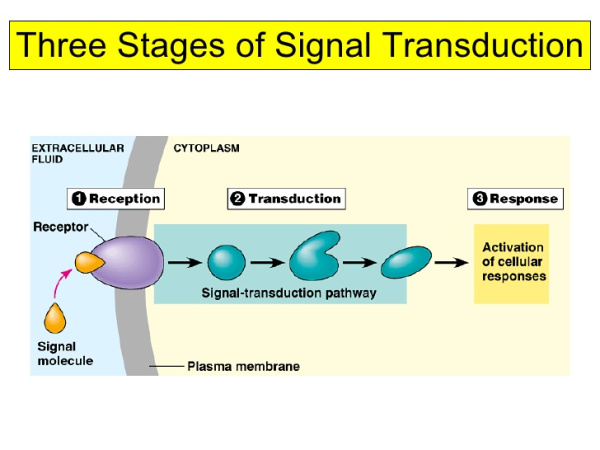Haseung Jun
Annika Tekumulla
AP Biology 🧬
358 resourcesSee Units
Transduction is the conversion of a signal into a cellular response. Transduction occurs in one step but the majority of the time it takes multiple changes. Think of it as the translation of the ligand into a response process with instruction manuals.
These multiple steps are called the signal transduction pathway. The signal transduction pathway is when a small collection of signal molecules produce a large response across the cell. The large response across the cell is called the cascade effect. The response of a cascade can be cell growth, gene expression, or secretion of molecules.
Memory Tip: A good way to think about the signal transduction pathway is like a waterfall or a line of falling dominoes.

Image courtesy of Giphy.
Regardless of the distance between the cells, cell communication always follows the same 3 steps: reception, transduction, and response.
- Reception occurs when the signal (can be a chemical, peptide, or protein) is detected when the ligand (signaling molecule) binds to the receptor protein in a target cell. This causes a change in the shape of the cytoplasm of the inside of the receptor. Then, transduction occurs.
- In transduction, the signal is transmitted through the cell and is amplified.
- Finally, the third step is the response. The response is when the signal is carried out. An example of a response is when the cell activates RNA polymerase which leads to the transcription of a gene.

Image courtesy of Winnacunnet Biology.
Reception
Cell surface receptors are receptors that cover the entire membrane. These receptors are important because most signaling molecules are too big to cross the plasma membrane.
The plasma membrane contains a phospholipid bilayer. The heads of the phospholipid are “water-loving” which are called hydrophilic. The tails of the phospholipid are “water-hating” which are called hydrophobic.
The phospholipid bilayer is very important because it creates a barrier between the inside and outside of the cell.
Examples of cell surface receptors
Ion Channel Receptors involves a channel that opens and closes. The channel is used to allow the passage of ions across the membrane.
Memory Tip: Think of ion channel receptors as a toll booth. Just like a channel receptor, a toll both opens and closes after an action is made.
G-Protein-Coupled Receptors: Through this process, the ligand binds to the outside part of the cell and changes the form of the inside cytoplasm. This causes a G protein to bind and activate the enzyme adenylyl cyclase. Adenylyl cyclase converts ATP (energy) to cyclic-AMP.
Finally, cyclic-AMP activates other molecules inside the cell which finally leads to the cellular response.
Transduction
Phosphorylation
We have a message. We were able to receive it. So how are proteins exactly activated? Proteins are activated in a process called phosphorylation. Essentially, a phosphate group is added to an already-existing protein to activate it. This phosphate group just comes from the cytoplasm ATP (adenosine triphosphate). When this is added to the protein, the protein will get "powered on" and start doing its job, while the ATP turns into ADP (adenosine diphosphate). After its job is over, the phosphate group will be taken off, powering off the protein (it's a waste of energy to have everything on right? 😉)
Amplification
There's a process within transduction called amplification. Not every signal leads to amplification, but it is a step that can be included. Amplification steps are a sequence of turning on communication pathways to amplify the response, or a process to make the transduction process faster. An example of this is the cAMP or the G-protein, which can be activated with GTP.
Transduction has a link to evolution
Since transduction occurs in an animal, bacterial, plant, and yeast cells, it shows that the signal transduction pathway has evolved from a common ancestor.
Isn’t it crazy that all these different organisms could have something in common?!

Image courtesy of Giphy.
Response
Depending on the ligand, the response can be anything. This can be turning on an enzyme, transporting a molecule, etc.
Special Cases
Like everything, the signal-transduction pathway has special cases! Two examples are lipid hormones and secondary messenger.
Lipid Hormones
Lipid hormones are a special type of ligand that are made out of...well... lipid. And since the cell membrane is made up of lipid, it doesn't need a receptor on the cell surface. Instead, it can pass through the cell membrane without a transport protein, and the receptor protein is actually inside the cell.
Then, this reception actually produces a transcription factor, and an entirely new protein is synthesized from DNA to mRNA to ribosome. Because the protein is made from scratch in response to the ligand, it can take up to an hour to create a response to the ligand! But on the bright side, slower response means the protein is more long-lasting, so a more functional (?) protein will be created.
Secondary Messenger
As the name suggests, a secondary messenger is just a second messenger. A receptor at the cell's surface receives a ligand, and this activates the transport channel. The transport channel is then opened, where the secondary messenger is allowed to enter the cell. After entering the cell, the secondary messenger binds to the appropriate protein to produce a messenger.
Browse Study Guides By Unit
🧪Unit 1 – Chemistry of Life
🧬Unit 2 – Cell Structure & Function
🔋Unit 3 – Cellular Energetics
🦠Unit 4 – Cell Communication & Cell Cycle
👪Unit 5 – Heredity
👻Unit 6 – Gene Expression & Regulation
🦍Unit 7 – Natural Selection
🌲Unit 8 – Ecology
📚Study Tools
🧐Exam Skills

Fiveable
Resources
© 2025 Fiveable Inc. All rights reserved.